Certified Clinician
 
Currently Offline
Posts: 81
Likes: 0
Joined: Mar 16, 2011 12:32:15 GMT -6
|
Post by philosophydoc on Jun 16, 2011 22:30:27 GMT -6
Thanks, Cruiser...I've never run across a carb that had a cooling line run to it.
Jeff, so far, with battery hooked up and key turned on (but not starting bike) , the horn, radio, and passing lights work. Tried brake lights, but no go.
Will keep you posted when I try to start it tomorrow...
|
|
Certified Clinician
 
Currently Offline
Posts: 81
Likes: 0
Joined: Mar 16, 2011 12:32:15 GMT -6
|
Post by philosophydoc on Jun 16, 2011 16:43:11 GMT -6
Okay -- gasket for water pump arrived today, so it is in (loctite on bolts). Also put in a new magnetic oil plug, added oil, and just finished adding coolant (Prestone 50/50). I will try to start it up tonight or tomorrow, but as I was burping hoses, I came across something I wasn't expecting. When I replaced all the hoses, here is one hose that now looks odd to me. Look at the hose exiting on the left from the radiator cap opening: 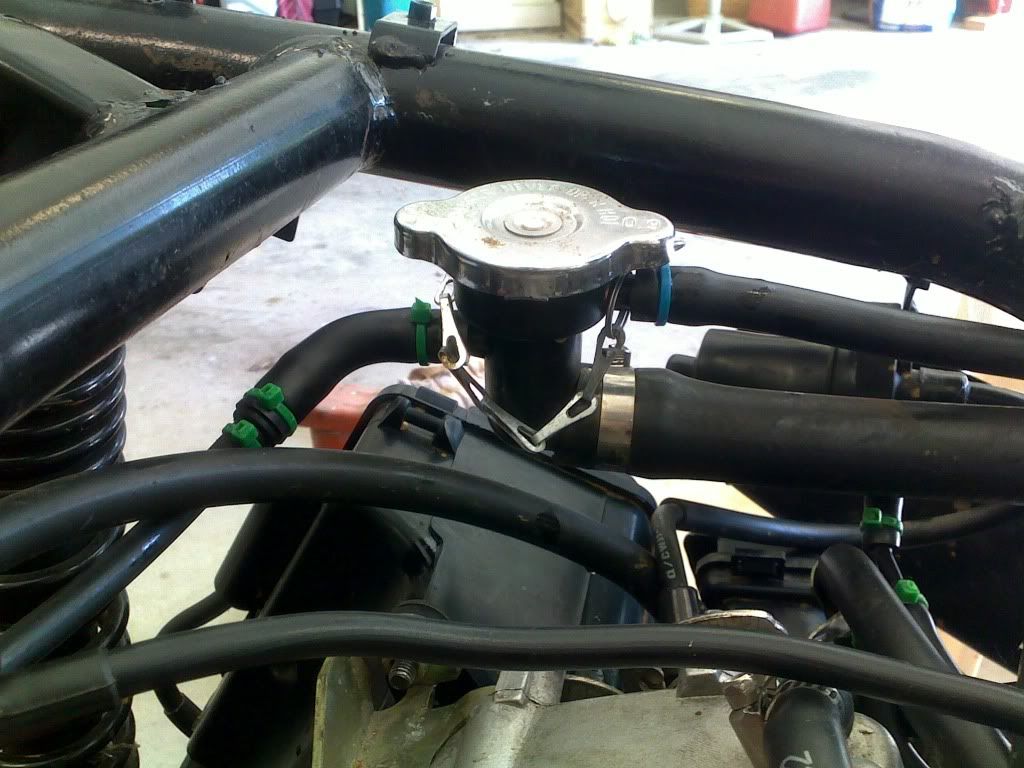 It loops around and terminates at the carb here (it is the center tube -- the green tie just to the left of the red tie, red denoting the fuel line): 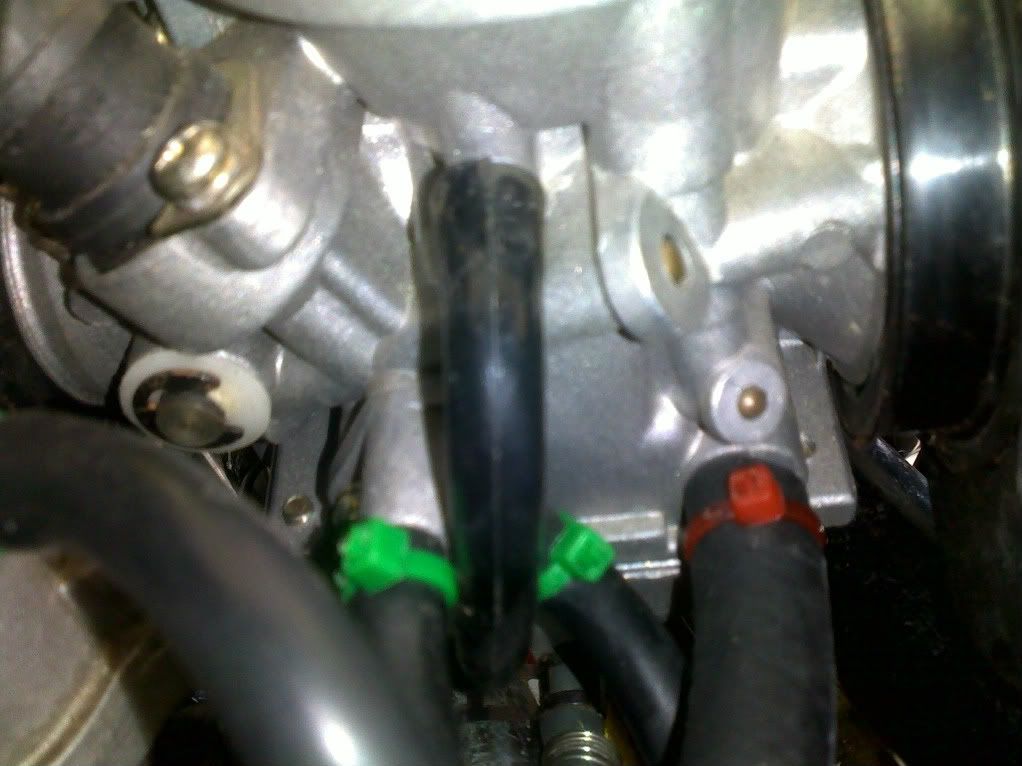 Is this correct? Does this mean that coolant can flow in this line? I am certain I didn't misconnect the hoses -- this is how they were when I received the bike). Is this a mistake, or okay? Thanks |
|
Certified Clinician
 
Currently Offline
Posts: 81
Likes: 0
Joined: Mar 16, 2011 12:32:15 GMT -6
|
Post by philosophydoc on Jun 12, 2011 15:23:15 GMT -6
Okay, hooked up battery, turned key on (Omega symbol, correct?). What works: passing light, radio, horn Turn signals, license plate light, brake lights do not work (tried signals, squeezing L and R brake handles...nothing). I am currently waiting for a water pump impeller cover gasket, so I did not try to turn it over, as the cooling system is drained. Also, is this a extension for adjusting the A/F screw? It connects to the bottom of the carb....? Any idea where it attaches? 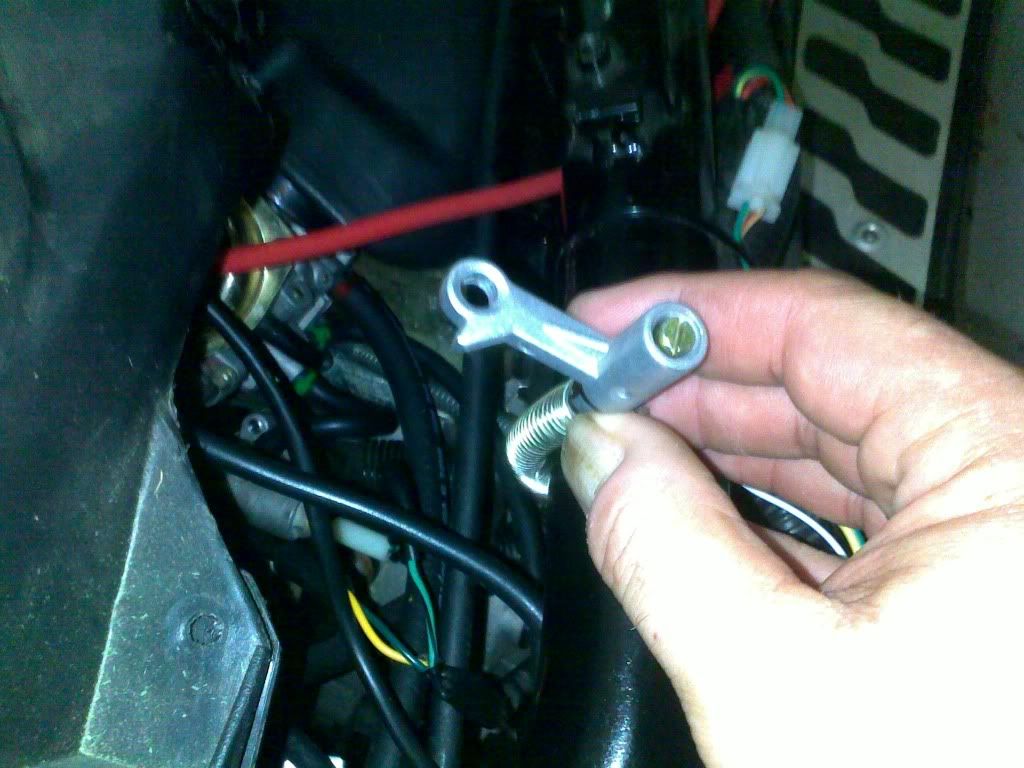 |
|
Certified Clinician
 
Currently Offline
Posts: 81
Likes: 0
Joined: Mar 16, 2011 12:32:15 GMT -6
|
Post by philosophydoc on Jun 11, 2011 22:23:08 GMT -6
At helixparts.com, found the gasket plus shipping for $5.82, so I pulled the trigger. (Everyplace else wanted between 8-10 bucks for shipping -- at helixparts it was three bucks. FYI...)
|
|
Certified Clinician
 
Currently Offline
Posts: 81
Likes: 0
Joined: Mar 16, 2011 12:32:15 GMT -6
|
Post by philosophydoc on Jun 11, 2011 17:43:53 GMT -6
|
|
Certified Clinician
 
Currently Offline
Posts: 81
Likes: 0
Joined: Mar 16, 2011 12:32:15 GMT -6
|
Post by philosophydoc on Jun 11, 2011 16:44:44 GMT -6
Went to clean out coolant (bike has been in garage, not running for 2 years) and nothing came out when I pulled the drain screw out. Pulled hose off inlet to impeller, and found the impeller cover tube full of calcified gunk. Removed impeller cover, cleaned it out with a steel brush, inside and out: 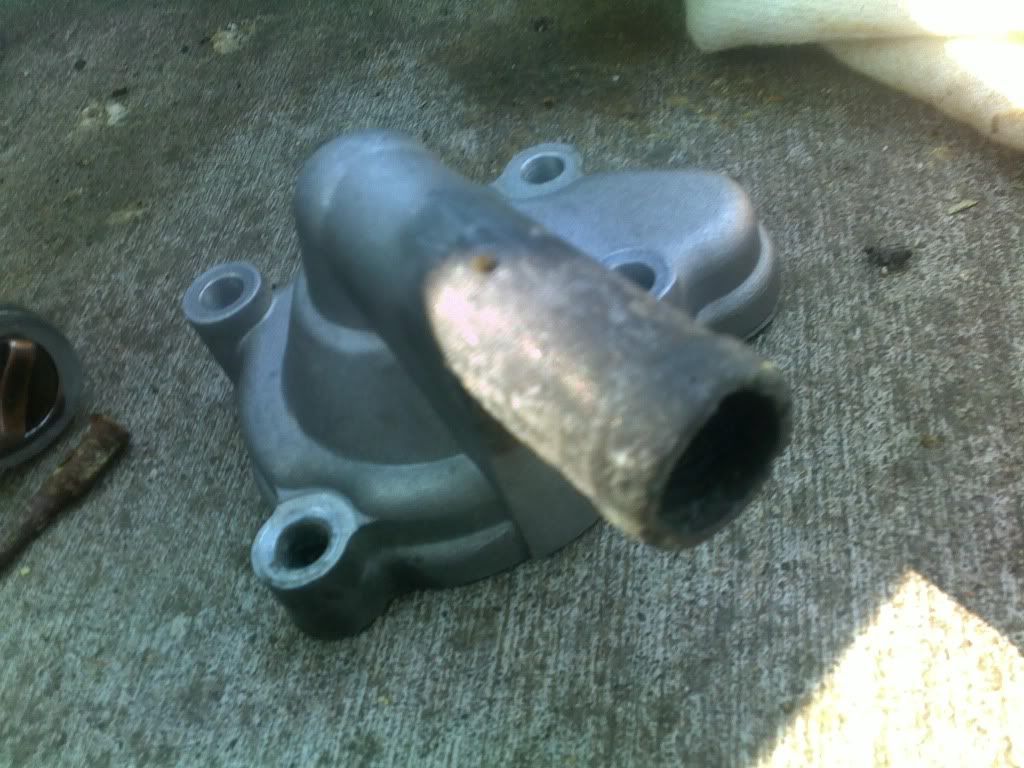 Pulled impeller off (remember - left hand threads) and some calcified gunk there, but not nearly as bad. Cleaned off impeller, looks good...here's the back side, and as you can see the seal washer is fine: 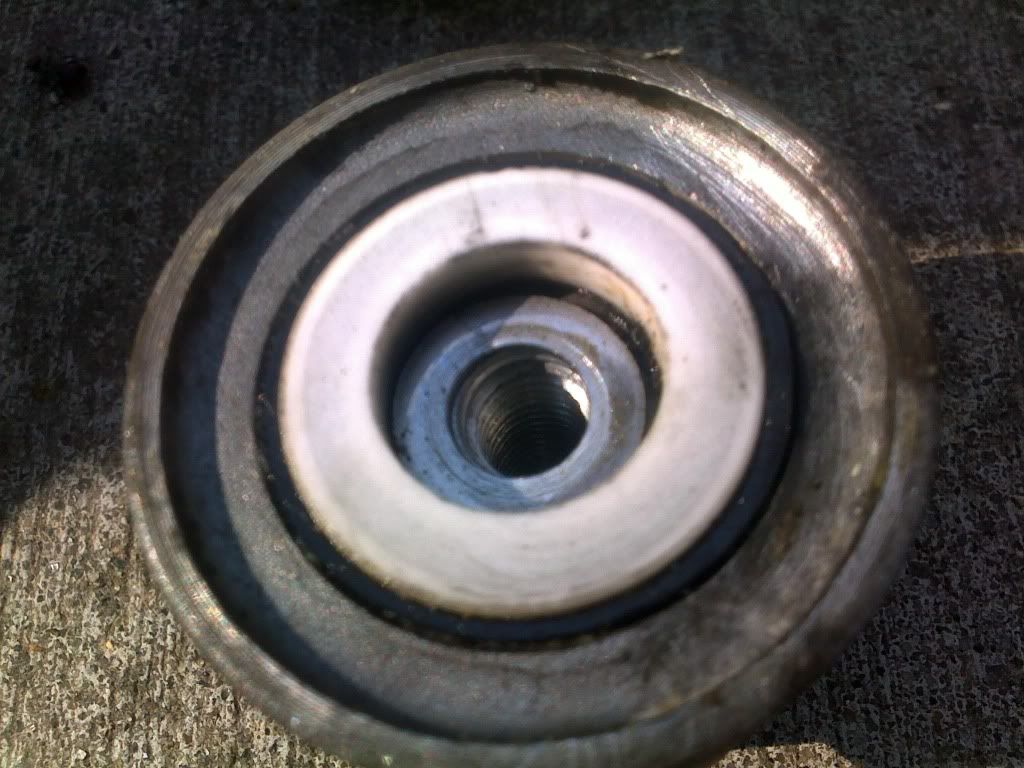 I wiped off/cleaned up the water pump...have no desire to pull the entire pump, but will if necessary. My question concerns the following picture ... see the greyish stuff (looks like plumber's putty, but is harder, and is deteriorating) -- what is that?  Helix manual has nothing listed, only points to "mechanical seal" which to my eyes appears okay. Should there be some sort of sealant smeared on here? Three questions: (1) Is there any reason not to simply scrape this grey gunk out and reinstall impeller? (2) The gasket for impeller cover is 90% intact and good...can I smear some "Form-a-gasket" over the 1/2 inch that's not good and be okay, or should I get a new gasket? (3) And the big question -- given the gunk I found, is it necessary to pull the entire water pump? Obviously I want to make sure the cooling system is clean, and I am wondering if I need to pull the entire pump or if I can re-install everything and flush the system out (using some kind of cleaner -- suggestions?) I cannot "turn" the water pump by hand, but I have no idea if I should be able to... Since I bought the scooter in parts, I cannot tell you if it ran hot beforehand, etc. It had 137 miles on when it busted a rocker arm, and the original owner tore it apart, replaced the rocker arm, then lost interest in it, sold it to me, and I stored it indoors for 2 years until now. Thanks in advance... |
|
Certified Clinician
 
Currently Offline
Posts: 81
Likes: 0
Joined: Mar 16, 2011 12:32:15 GMT -6
|
Post by philosophydoc on Jun 7, 2011 16:17:47 GMT -6
Okay, the original discussion of all this began here: scooterdoc.proboards.com/index.cgi?board=250cc&action=display&thread=3375I bought a scooter in parts, and am putting it back together. The mechanicals aren’t that tough, but the wiring is the issue. I have accounted for all the wiring (i.e. I have made all the connections) save for 6 cut wires. The colors of the cut wires, coming down from the instrument cluster are: Red/Green Yellow Yellow Black Pink Blue/Red I also have a fuse box with 4-10 amp fuses, but no place to connect it. (WARNING: The box o’parts that came with the bike had several “extra” parts not connected to the bike, so I cannot even be sure the fuse box IS part of my scooter. But since a faceplate on the bike identifies it as a 2008 Jonway YY250T-2, which does have a fuse box, I am assuming this goes with the bike). Coming out of bottom of the fuse box are 8 wires (Four fuses x 2 wires to each fuse = 8), terminating in a six pin (flat blade) molex connector. (How do you get eight wires into a six pin connector? Three of the eight are black, and they are spliced into a single wire). So the colors at the connector are these: Black Yellow Brown Light Blue/White Brown/Blue Blue/Red I cannot find any wiring diagram that seems to make sense of the wire colors I have, and need to “trace” the cut wires, but I have no earthly idea how to do that. I have a multimeter, but no experience using it. The ideal solution (more hoped for than anything else) is that the 6 cut wires “connect” to my 6 pin molex connector. Colorwise, there are three matches between the cut wires and the molex connector (between the Yellow, Black, and Blue/Red wires). That leaves me with three sets of unmatched wires: Cut wires Red/Green Yellow Pink Molex Connector from Fuse Box Brown Brown/Blue Light Blue/White So at this point I’m stumped as to how to proceed. Battery is not hooked up, but I can do that if need be. |
|
Certified Clinician
 
Currently Offline
Posts: 81
Likes: 0
Joined: Mar 16, 2011 12:32:15 GMT -6
|
Post by philosophydoc on Jun 5, 2011 13:54:30 GMT -6
Not running yet, but only because I still have six cut wires I need to trace and connect up before I can try to turn it over. I need to get some advice from Doc JR about how to proceed.
|
|
Certified Clinician
 
Currently Offline
Posts: 81
Likes: 0
Joined: Mar 16, 2011 12:32:15 GMT -6
|
Post by philosophydoc on Jun 2, 2011 12:09:46 GMT -6
Since I have learned a lot on this forum, let me pass along something that may help others one day...
The bolt I sheared off (one of two attaching the intake manifold to the cylinder) was an M 6 x 1.0 x 20 flanged head bolt.
I went to Autozone and bought a box of 3 non-flanged bolts for $2.19...but when I went to install them, it turns out the indentations on the side of the intake manifold are spec'd for a flange head bolt, because the flange head takes an 8mm socket, while the non-flange head bolts I bought take a 10mm socket. In short, there isn't enough clearance to squeeze a 10mm socket around a "standard" (read "non-flange head") M 6 x 1.0 x 20mm bolt, at least when used to attach the intake manifold.
I think the bolt head sheared off because the bolt bottoms out -- it simply can't go any further. This created a second problem -- the non-flanged head bolt (because it is a non-flanged head) has about a 1mm longer threaded shaft than the flanged version, making it impossible for the new bolt to descend deep enough into the hole to get the intake manifold snugged up. Hence I had to hacksaw off about 2 mm of my replacement bolt. And since I couldn't get a 10mm socket (even a thin-walled one) around the new bolt head, (no room around the intake manifold) I could only use this replacement bolt for the top bolt, as I could get an open end wrench around it to tighten it up. Heaven forbid trying to do that on the bottom intake manifold bolt.
MORAL: Flanged or non-flanged heads sometimes make a big difference, even if both are the "same" size bolt.
Lots of info, but it may help someone someday. (My kids say "Ask dad for the time, and you get a history of the clock!")
|
|
Certified Clinician
 
Currently Offline
Posts: 81
Likes: 0
Joined: Mar 16, 2011 12:32:15 GMT -6
|
Post by philosophydoc on Jun 2, 2011 10:43:18 GMT -6
Okay, I am reattaching the airbox, and no amount of twisting, turning, cajoling, cussing, etc. seems to be working to get tight connections at the airfilter and the carb. I have loosened the retaining rings on the intake manifold and both ends of the airbox (and I even loosened the bolt attaching the airfilter to the frame) to maximize the amount of "play" I have, but it's as though I can't get the right set of angles to have the airbox fit tightly to both the carb and airfilter. I can get it tight at the carb, but then this is what it looks like at the airbox/airfilter connection: 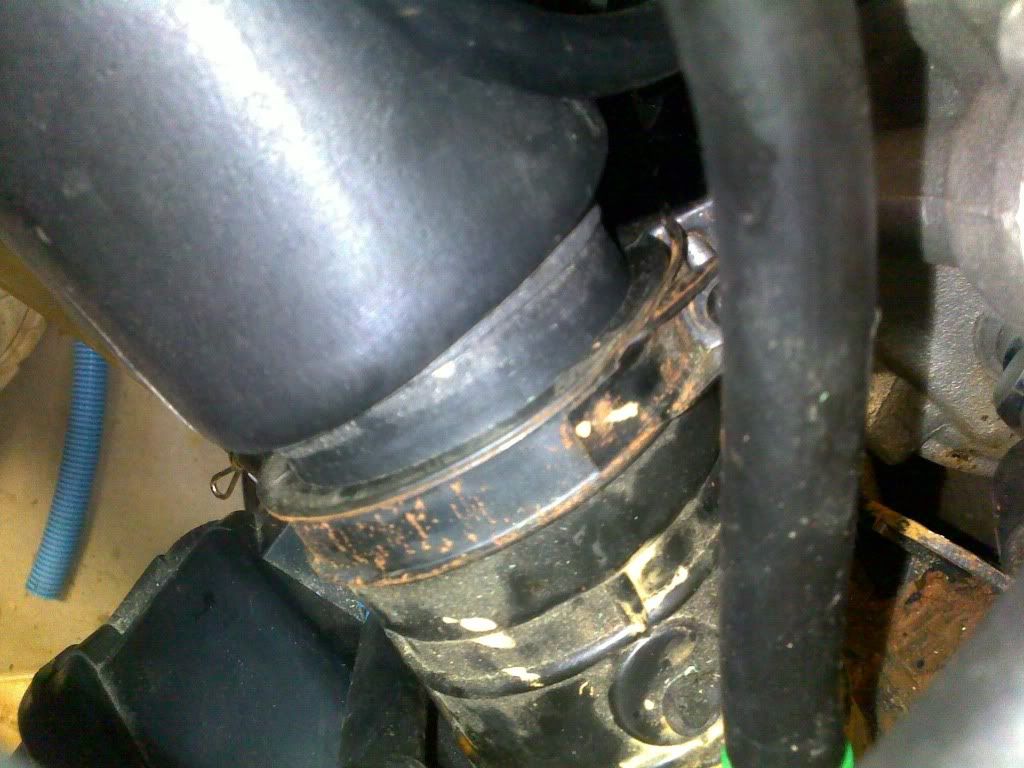 I can tighten it up, but there is still a lot of wiggling possible, and I don't know how much is too much. Again, the disadvantage I have in all of this is that I have never seen this bike (or any scoot) all together (I got it in parts), and hence I don't have anything to draw on visually (i.e. "how did it look when you took it apart?"). I'd like to have more of the airbox pushed past the retaining ring (read lots of posts about air leaks, and hence may be overly concerned), but this is the best I can do. Any advice? Does this look normal or not? Should I keep at it, or accept what I have? |
|
Certified Clinician
 
Currently Offline
Posts: 81
Likes: 0
Joined: Mar 16, 2011 12:32:15 GMT -6
|
Post by philosophydoc on May 31, 2011 21:48:41 GMT -6
Well, some days you're the dog, and some days you're the hydrant...
After letting the cylinder sit in diesel and then purging it, I went to re-attach the intake manifold. Putting on the second bolt (and having read many posts where errant air leaks have fouled up many a scooter), I decided to give it one more half turn to cinch it up tight...and promptly sheared off the bolt head.
Spent the next two hours (1) running to Sears to buy a screw extractor, (2) breaking off two 5/64 drill bits trying to drill out the shaft of the shorn bolt to insert said extractor, and (3) heading to Home Depot to snag a black oxide bit before finally extracting the bolt. All in a 95 degree garage, with 80% humidity, and a few rather friendly wasps checking my every move.
Boy, I hope this thing is fun to ride.
|
|
Certified Clinician
 
Currently Offline
Posts: 81
Likes: 0
Joined: Mar 16, 2011 12:32:15 GMT -6
|
Post by philosophydoc on May 31, 2011 9:09:53 GMT -6
It's sitting in diesel now...
I bought the bike in parts, and never saw it run, so if the old owner allowed water to get into the cylinder, I don't know about it. The bike has sat in my garage for the past 22 months, so I don't know if that had an impact, but the cylinder was never open during that time.
Odometer says bike has 137 miles, and the condition of everything I can see (i.e. rubber parts like belt, hoses, intake manifold, etc.) supports that low mileage. Carb is practically pristine, and the belt (Powerlink 828 x 22.5) is likewise in great shape.
Already bought new plug after pulling old one, and later today I will (following tvnacman's advice), having inserted the plug, opened the intake valve and filled the cylinder with diesel, will pull the plug, hand crank the drive pulley a number of times to purge the diesel, and put it back together.
Doc, I now have everything ready to actually turn the bike over, but I still have six cut wires I need to trace. You've forgotten more about scooter electronics than I'll ever know (!), so should I hook up the battery and start checking those cut wires? If so, what should I check for? Or should I see if it will turn over at all?
Thanks again.
|
|
Certified Clinician
 
Currently Offline
Posts: 81
Likes: 0
Joined: Mar 16, 2011 12:32:15 GMT -6
|
Post by philosophydoc on May 30, 2011 16:00:01 GMT -6
tvnacman, I am a little leery of putting diesel into a gas cylinder...any reason to use diesel rather than plain old gas?
A little internet searching seems to confirm that diesel is fine as a degreaser, so I'll give it a whirl...thanks,
|
|
Certified Clinician
 
Currently Offline
Posts: 81
Likes: 0
Joined: Mar 16, 2011 12:32:15 GMT -6
|
Post by philosophydoc on May 29, 2011 9:07:55 GMT -6
As I examine the old plug, and look at what got "burped" out of the spark plug hole when I pulled the plug and rotated the drive shaft, it looks a bit more "crusty" than I like, and hence I am seeking advice on how to flush out the cylinder, short of pulling off the cylinder head. Here's a shot of the plug, with a few specks of what I found inside: [  Again, I am not sure anything is amiss save for the gunk that can build up in a cylinder when the engine hasn't been fired in over two years...or is that an unreasonable assumption? I had though to rotate the piston to TDC and then flushing it with solvent (or gas)? I suppose I could rig up a narrow tube on my Shop Vac and suck out all I can...any other advice? Or should I leave well enough alone...? |
|
Certified Clinician
 
Currently Offline
Posts: 81
Likes: 0
Joined: Mar 16, 2011 12:32:15 GMT -6
|
Post by philosophydoc on May 28, 2011 18:59:44 GMT -6
Went to Lowe's, picked up a set of metric deep well sockets for $10, and pulled the plug. Turned completely, but a lot of gunk came up out of the cylinder (all liquid...I think). Unfortunately, even after I pulled the top off the cylinder to expose the timing chain and cams, I could detect no "index mark"whatsoever. So I replaced everything and will hope that the valves aren't so far out of whack that it will at least turn over.
I will replace the plug -- it is an NGK DR8EA, and looked a little crusty. I know the spec for a Helix clone is the DPR6EA-9...should I go with my original plug size (which I think was original, as the bike only has 137 miles on it).
|
|

